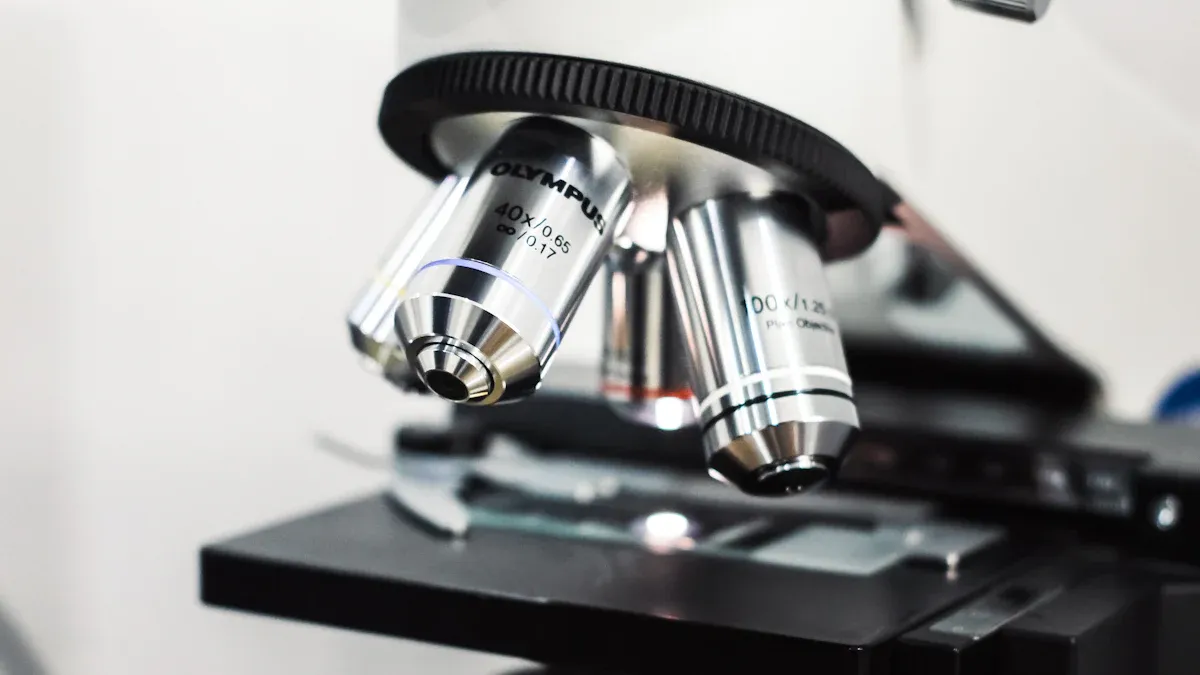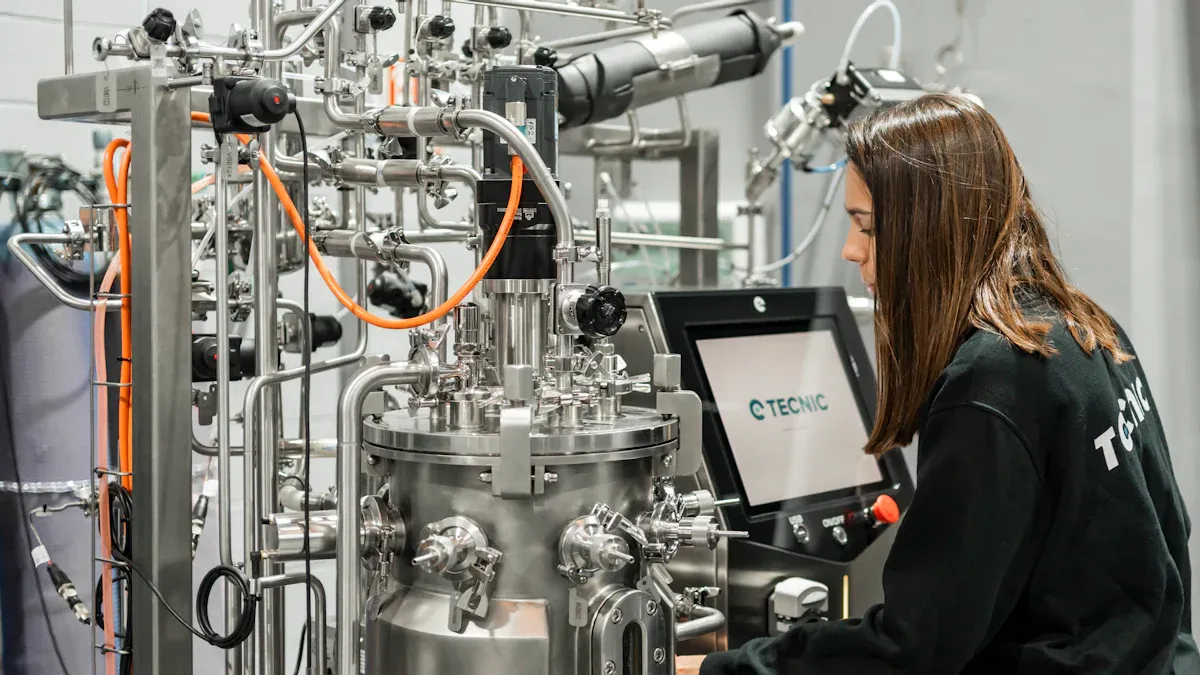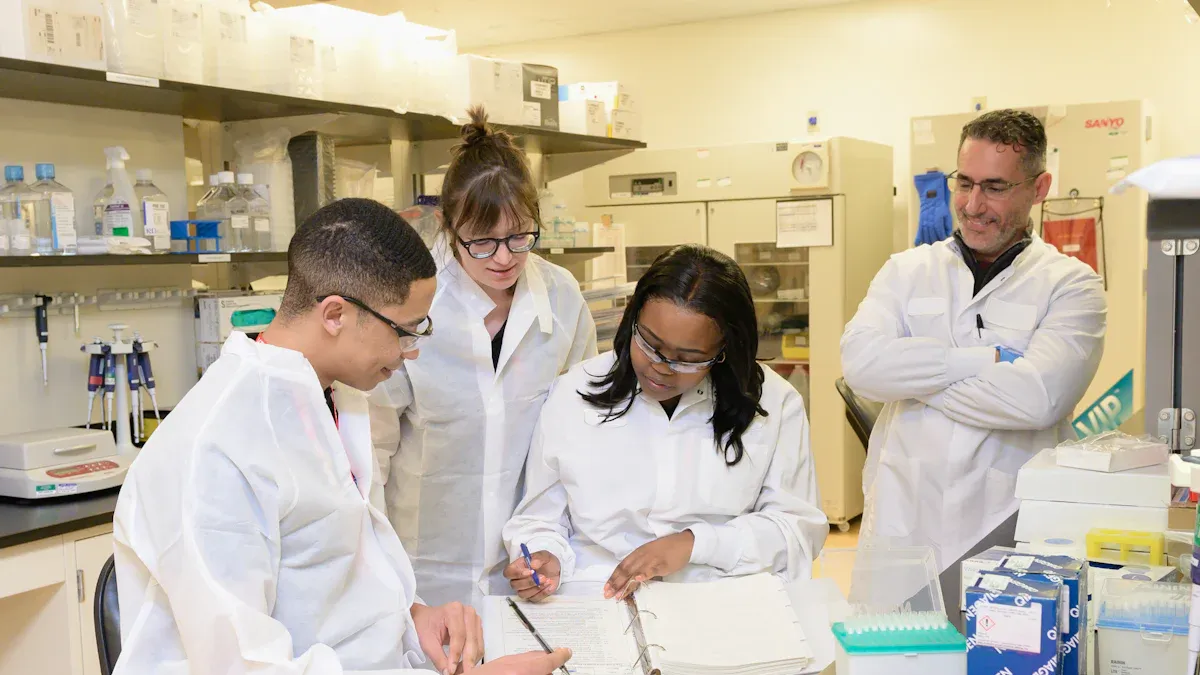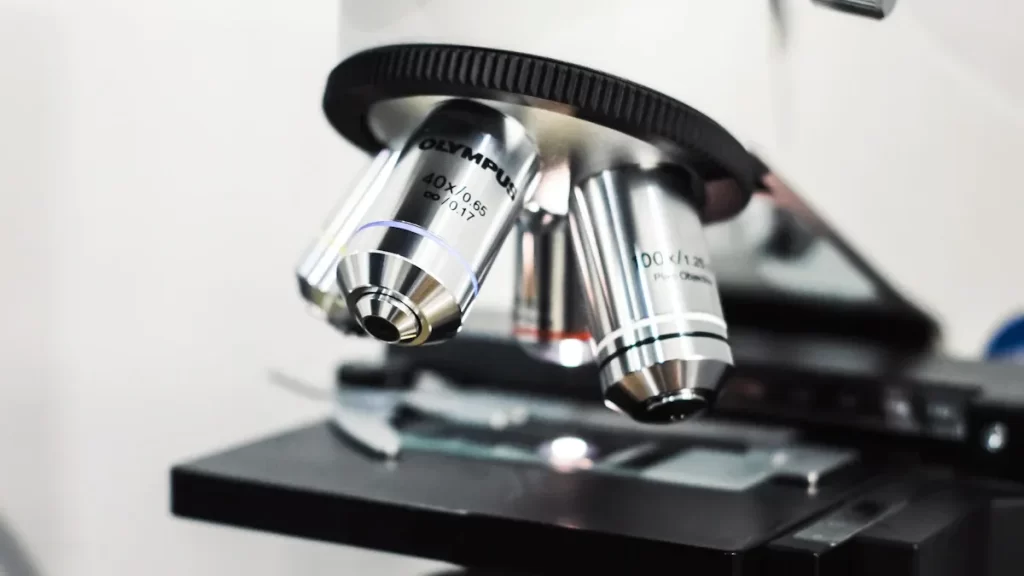News & Events
Marvelous Mass Spectrometry Oxford Moves Molecules

You see Oxford at the forefront of mass spectrometry oxford, where researchers like Justin Benesch use native mass spectrometry to study proteins in their natural states. This approach leads to real progress in science and medicine. Oxford’s innovations help you discover new biomarkers for cancer, save time with antibody-free detection, and monitor thousands of proteins at once. Sensitive instruments can even analyze tiny samples from clinical trials. These advances shape the way you understand and use molecules every day.
Key Takeaways
- Oxford leads in mass spectrometry research, helping you understand proteins and diseases better.
- Advanced facilities at Oxford allow for precise analysis of tiny samples, improving diagnostics and treatment options.
- Collaborations with industry enhance mass spectrometry applications, leading to innovative tools for disease detection.
- Emerging trends in mass spectrometry, like machine learning, improve detection speed and accuracy in clinical settings.
- Oxford’s research supports personalized medicine, tailoring treatments based on individual molecular profiles.
Mass Spectrometry Oxford

Research Groups
You find that mass spectrometry oxford brings together some of the brightest minds in science. Professor Philipp Kukura leads a group that focuses on mass photometry and the study of biomolecular structures. His team uses mass spectrometry to look at how molecules interact and change. You see how this work helps you understand proteins and other important molecules in your body. The research groups at Oxford use mass spectrometry oxford to answer big questions in biology and medicine. They explore how proteins fold, how drugs bind to their targets, and how diseases change the molecules inside your cells. You benefit from their discoveries every time you read about a new treatment or a breakthrough in disease detection.
Oxford’s research groups use mass spectrometry oxford to reveal the hidden world of molecules. You can see how their work shapes the future of science and health.
Facilities
When you visit the Mass Spectrometry Research Facility at Oxford, you see a collection of advanced instruments. The facility houses 21 mass spectrometry systems. These machines have a total value of £7.5 million. You realize that this investment shows how much Oxford values mass spectrometry oxford. The facility gives you access to tools that can measure tiny amounts of molecules with great accuracy. You can study proteins, lipids, and small molecules in ways that were not possible before.
- 21 mass spectrometry systems
- Equipment valued at £7.5 million
The TDI Mass Spectrometry Laboratory stands out as a leader in drug development. You use advanced mass spectrometry techniques to analyze complex biological samples. This helps you understand how diseases work at the molecular level. The laboratory supports high-throughput proteomics, which lets you discover new biomarkers and develop targeted therapies. During the COVID-19 pandemic, the lab used mass spectrometry to group patients by disease severity. This work helps you and doctors create better treatments and move toward personalized medicine.
You see that mass spectrometry oxford is more than just a set of machines. It is a place where you can push the boundaries of science. The facilities and research groups work together to give you new ways to explore the molecular world. Every discovery you make with mass spectrometry oxford brings you closer to solving real-world problems in health and disease.
Research and Innovation

Major Projects
You see Oxford leading the way in mass spectrometry research. The university focuses on several important areas. You learn about proteomics, which helps you understand proteins and how they work in your body. Metabolomics lets you study small molecules called metabolites. These molecules show you how cells use energy and respond to changes. Oligonucleotide research uses mass spectrometry to analyze short strands of DNA and RNA. You discover how native mass spectrometry allows you to study biomolecules in their natural state. High-throughput screening uses mass spectrometry to test many compounds quickly, which helps you find new drugs faster.
Here is a table that shows the main research areas at Oxford:
| Project Area | Description |
|---|---|
| Proteomics | Study of proteins, their functions, and interactions. |
| Metabolomics | Analysis of metabolites to understand metabolic processes. |
| Oligonucleotides | Mass spectrometry applications for oligonucleotide analysis. |
| Native MS | Study of biomolecules in their native state using mass spectrometry. |
| High-Throughput Screening | Rapid screening of compounds in drug discovery using mass spectrometry. |
You also see Oxford working with industry partners. You learn about the CASE DPhil studentship with Quantum Detectors Ltd. This partnership helps you develop new tools for mass spectrometry. The Oxford Chemistry Department collaborates on time of flight mass spectrometry projects. These efforts push the boundaries of genomic research and help you solve real-world problems.
Oxford uses imaging mass spectrometry and machine learning to advance research. You see how these tools let you study molecules at the single-cell level. You can investigate cellular differences and classify cell types based on their molecular profiles. Oxford validates these methods using t-MALDI-2-MSI with a pixel size of 2 µm. You read about case studies, such as cocultivation of Vero-B4 and Caki-2 cells. You also see how researchers monitor lipid changes during THP-1 monocyte differentiation. These projects show you the power of combining mass spectrometry, maldi, and machine learning in genomic research.
Matrix Assisted Laser Desorption Ionisation Mass Spectrometry
You discover that matrix assisted laser desorption ionisation mass spectrometry, or maldi, is a key technique at Oxford. Researchers use maldi to create detailed molecular maps of tissues and tumors. You see how maldi workflows integrate with other technologies, such as TIMS and laser-capture microdissection. This integration improves molecular analysis and helps you find new markers for cancer treatment.
Oxford’s maldi workflows give you better diagnostic tools. You learn how maldi helps identify the determinants of metastatic spread in colorectal carcinomas. This knowledge can reduce unnecessary surgeries and guide treatment decisions. You see how maldi supports personalized medicine by tailoring therapies to each patient’s molecular profile. Researchers use maldi to discover new molecular markers for cancer and other diseases. These advances improve patient outcomes and help you understand the genomic basis of disease.
You benefit from Oxford’s focus on maldi and mass spectrometry. The university’s research helps you move toward personalized medicine. You see how maldi creates molecular maps that guide doctors in choosing the best treatments. Oxford’s work in maldi and mass spectrometry gives you new ways to study genomic changes in health and disease.
Oxford’s research in mass spectrometry and maldi brings you closer to understanding the molecular world. You see how these advances shape the future of genomic medicine and research.
Applications and Analysis
Biomedical Detection
You use mass spectrometry for rapid detection and identification of pathogens in clinical settings. This technology gives you sensitive molecular diagnostics for infectious diseases. You can detect dna from pathogens and track genetic mutations. Mass spectrometry helps you with screening for viral infections and detection of mutations in patient samples. You rely on this technology for vaccine authenticity screening and for the detection of pathogens in blood. Molecular diagnostics with mass spectrometry supports identification of pathogens and detection of dna changes. You see how this improves diagnostics and helps you respond quickly to outbreaks. Clinical applications include detection of pathogens, mutation detection, and dna analysis for genetic disorders. You use mass spectrometry for pathogen identification and molecular diagnostics in diagnostics labs. This technology gives you fast data for diagnostics and screening.
Environmental Analysis
You apply mass spectrometry to environmental analysis for detection of pathogens and dna in water and soil. You use molecular diagnostics to identify pathogens and track genetic changes in the environment. Mass spectrometry enables detection of dna from pathogens and supports screening for viral infections in wildlife. You rely on this technology for detection of pathogens in food and water supplies. Molecular diagnostics with mass spectrometry helps you with identification of pathogens and detection of genetic mutations in environmental samples. You use mass spectrometry for rapid analysis and identification of dna from pathogens. This technology supports detection of pathogens and screening for infectious diseases in the environment. You benefit from sensitive diagnostics and fast data collection.
Mass spectrometry at Oxford enables rapid, sensitive, and spatially resolved molecular analysis. You use spatial imaging mass spectrometry for high-throughput chemical analysis. Microprobe and microscope modes give you detailed spatial resolution. You reduce sample degradation and collection times. You detect all mass peaks at once, needing fewer laser shots for data.
Industrial Partnerships
You see Oxford working with industry to advance mass spectrometry applications. The university partners with companies to improve molecular diagnostics and detection of pathogens. You benefit from these collaborations through new tools for screening and diagnostics. Here is a table showing a notable partnership:
| Partnership | Companies Involved | Focus Area | Outcomes |
|---|---|---|---|
| Notable | Oxford Medical Diagnostics (OMD) and V&F Analyse- und Messtechnik GmbH | Mass spectrometry for diabetes screening | Development of Acetone Breath Analyzer, joint research opportunities, contract batch sample analysis service |
You use these advances for detection of pathogens, dna analysis, and molecular diagnostics in industry. Industrial partnerships help you with screening, identification, and diagnostics for infectious diseases and genetic disorders. You see how mass spectrometry supports vaccine authenticity screening and detection of pathogens in manufacturing.
Breakthroughs and Impact
Novel Techniques
You see Oxford leading with new techniques in mass spectrometry. Surface mass spectrometry lets you study molecules directly from tissue surfaces. You use this for fast detection and identification of proteins and lipids. Omics discovery helps you analyze thousands of molecules at once. You rely on mass spectrometry for detection of changes in cells and tissues. Imaging mass spectrometry gives you spatial maps of molecules. You use these maps for identification of disease markers. Machine learning improves detection and identification by finding patterns in mass spectrometry data. You see how these advances make detection faster and more accurate.
You benefit from Oxford’s focus on technical development. Mass spectrometry now gives you better detection and identification in clinical and research settings.
Notable Discoveries
Oxford’s teams have earned major awards for their work in mass spectrometry. You learn about Carol V. Robinson, who received the 2023 John B. Fenn Award for her work on membrane proteins. She also became Dame Commander of the Order of the British Empire in 2013 for her services to science. These recognitions show you the impact of Oxford’s research. You see how mass spectrometry leads to new detection and identification methods for proteins. Oxford’s discoveries help you with identification of biomarkers and detection of disease. You use these findings for better detection and identification in clinical diagnostics.
- 2023 John B. Fenn Award for Distinguished Contribution in Mass Spectrometry
- Dame Commander of the Order of the British Empire (DBE), 2013
Collaborations
You see Oxford working with industry and other disciplines to advance mass spectrometry. The university uses the expression® CMS system, which gives you reliable detection and identification data. This partnership helps train students in mass spectrometry. You gain skills for future research and detection projects. Oxford values interdisciplinary training. You learn how to work with experts from different fields. This training improves detection and identification in collaborative projects. Industry interactions support knowledge transfer. You use mass spectrometry for detection and identification in education and research. These collaborations make detection and identification more effective.
| Collaboration Type | Benefit to You | Example |
|---|---|---|
| Industry Partnership | Better detection and identification tools | expression® CMS system |
| Interdisciplinary Training | Skills for detection and identification | Collaborative research projects |
| Educational Interaction | Knowledge transfer for detection | Student training programs |
Oxford’s collaborations give you new ways to use mass spectrometry for detection and identification. You see how teamwork leads to better results in clinical and research applications.
Future of Mass Spectrometry
Emerging Trends
You see mass spectrometry changing quickly at Oxford. New trends help you with detection and identification in many fields. You use these advances to improve high-throughput screening and sequencing. Here are some of the most promising trends:
- You use a new anion-exchange chromatography mass spectrometry (AEC-MS) protocol. This method helps you with selective detection of highly polar and ionic compounds.
- You apply this protocol to study gut microbiome metabolism. You also use it for antimicrobial resistance detection and cancer biomarker identification.
- You see high-throughput capabilities growing. These let you analyze more samples at once and speed up sequencing and detection.
- You use mass spectrometry with machine learning. This helps you find patterns in complex data and improve identification.
- You explore spatial transcriptomics. This trend lets you map molecules in tissues and improve detection and identification.
You notice that these trends help you with detection, identification, and sequencing in clinical and research settings. You use mass spectrometry to support genomic sequencing and high-throughput analysis.
Ongoing Projects
You find Oxford leading projects that shape the future of mass spectrometry. One project focuses on better detection and identification of central nervous system infections. You use mass spectrometry and next-generation sequencing to analyze brain fluid. This project helps you improve clinical detection and identification. You get more accurate results and better treatment options.
You see new technologies driving innovation at Oxford. The Technology Showcase event highlights advances in mass spectrometry for detection and identification. You learn about proteomic biomarkers and how they help with clinical development.
| Event Name | Focus Area | Key Outcomes |
|---|---|---|
| Technology Showcase | Proteomic Biomarkers Insights | Advances in mass spectrometry driving innovation in biomarker discovery and clinical development. |
You expect Oxford’s research to impact science and medicine worldwide. You use mass spectrometry for detection and identification in proteomics, metabolomics, and analytical techniques. You see more applications in pharmaceutical sciences, clinical chemistry, diagnostics, microbiology, and cell biology.
| Area of Impact | Description |
|---|---|
| Proteomics | You advance detection and identification of protein functions and interactions. |
| Metabolomics | You improve detection and identification of metabolic processes. |
| Analytical Techniques | You develop ion-exchange chromatography with mass spectrometry for new detection applications. |
| Applications | You use mass spectrometry for detection and identification in many fields. |
You focus on multi-omics integration, AI and machine learning, and spatial transcriptomics. These areas help you transform detection and identification in diseases beyond oncology, unlock insights from complex data, and redefine tissue analysis.
| Research Focus Area | Description |
|---|---|
| Multi-omics integration | You expand detection and identification to chronic conditions. |
| AI/ML applications | You use machine learning for better detection and identification in precision medicine. |
| Spatial transcriptomics | You improve detection and identification in tissue analysis with in situ multi-omics. |
You see Oxford’s mass spectrometry research leading the way in detection, identification, and sequencing. You use these advances to solve real-world problems and shape the future of science and medicine.
You see Oxford at the center of mass spectrometry innovation. You benefit from new methods that improve detection and identification in every field. Oxford’s teams create instruments for single-cell analysis and rapid protein identification. You use mass spectrometry for detection of metabolites, proteins, and disease markers. Faster scan rates and new technologies give you deeper detection and identification. You rely on Oxford’s advances for detection in clinical, environmental, and industrial settings. You see detection and identification become faster, more reliable, and more accessible. Oxford’s research shapes the future of detection and identification worldwide. You can expect mass spectrometry to keep moving detection and identification forward, unlocking new discoveries for you and the world.
- Oxford’s mass spectrometry enables rapid detection and identification of complex samples.
- You use new tools for detection and identification in clinical and research labs.
- Oxford’s innovations in mass spectrometry support detection and identification at every level.
You will see mass spectrometry at Oxford continue to lead detection and identification, driving progress in science and medicine.
FAQ
What is mass spectrometry and how does it help with detection?
Mass spectrometry lets you measure molecules by their mass. You use it for detection of proteins, DNA, and chemicals. This tool helps you find small amounts of substances in samples. You rely on it for detection in science, medicine, and industry.
How does Oxford improve detection using mass spectrometry?
You see Oxford use advanced instruments and workflows for detection. Researchers develop new methods for detection of disease markers and environmental changes. Oxford’s teams use imaging and machine learning to make detection faster and more accurate. You benefit from these detection advances in real-world applications.
Why is detection important in clinical and environmental research?
Detection helps you find diseases early and track pollution. You use detection to identify pathogens in blood or water. Early detection saves lives and protects the environment. Oxford’s detection methods give you reliable results for health and safety.
What are some real examples of detection at Oxford?
You find Oxford researchers using detection to group COVID-19 patients by disease severity. They use detection to identify cancer markers in tissue samples. Oxford’s detection work also helps you monitor air and water quality. These detection projects use real data and advanced technology.
How do you use detection in industry with Oxford’s mass spectrometry?
You use detection for quality control and safety checks. Oxford partners with companies to develop detection tools for food safety and drug testing. Detection helps you ensure products are safe and meet standards. Oxford’s detection research supports industry needs with reliable solutions.

